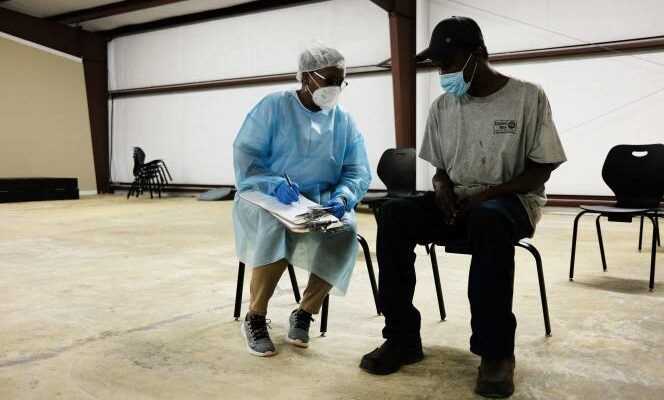More than 150 million people have been infected across the planet, including nearly six million in one week, according to a count by Agence France-Presse (AFP) from official reports on Friday, April 30. India and Brazil are now on the front line in the epidemic that Europe, like the United States, intends to leave behind by the summer.
Health measures reduced GDP in the first quarter by 1.7% in Germany, 0.4% in Italy, 0.5% in Spain, 3.3% in Portugal. Overall the euro area economy contracted by 0.6%.
New record in India with more than 400,000 contaminations
Some 401,993 new infections were reported on Friday, bringing the total in that country to more than 19.1 million. The number of deaths over the past 24 hours was 3,523, bringing the total to 211,853. India, overwhelmed by a surge in Covid-19 cases, lacks beds, medicine and oxygen to treat its patients.
US President Joe Biden has decided to impose restrictions on travelers from the country. The decision will take effect on May 4. However, the restrictions will not apply to students coming to the United States for classes next fall. India is the second best-represented nation among foreign students on American soil.
The Indian variant of the coronavirus, spotted in at least seventeen countries including France, the United Kingdom or Germany, is suspected of being more contagious, or even of leading to a decrease in the effectiveness of vaccines, but the unknowns remain numerous.
WHO approves Moderna’s vaccine
This messenger RNA vaccine “Joins the growing list of vaccines validated by WHO for emergency use”, said the World Health Organization (WHO) in a statement. It is the fifth to benefit from such validation from the UN health agency.
The WHO has already approved the vaccine from Pfizer-BioNTech, the two AstraZeneca sera manufactured in India and South Korea, and that from Johnson & Johnson, called Janssen. A decision is expected soon, in all likelihood next week, for the two Chinese vaccines, Sinopharm and Sinovac.
This procedure helps countries that do not have the means to determine on their own the efficacy and safety of a drug to have faster access to therapies and will allow the Covax system, set up by the WHO with partners (the Global Alliance for Vaccines and Immunization – GAVI – and the Coalition for Innovations in Epidemic Preparedness) to distribute Covid vaccines in particular in disadvantaged nations, to be able to consider having additional vaccines.
Washington also assured Friday to work with the World Trade Organization (WTO) to allow a “Equitable distribution” vaccines against Covid-19, according to a US trade official.
Of the more than 835 million doses that had been administered worldwide as of April 15, 48% had been administered in rich countries, compared to just 0.1% in the 29 poorest countries, according to calculations by the AFP.
Canada delays distribution of 300,000 doses of Johnson & Johnson
The Canadian Department of Health announced on Friday that it would delay the distribution of a delivery of 300,000 doses of the Johnson & Johnson Covid-19 vaccine received this week in Canada due to concerns about their quality. This was the first shipment of this single-dose vaccine from J&J received by Ottawa, according to local media.
The group is facing production problems in a plant in Baltimore, in the US state of Maryland, managed by the firm Emergent BioSolutions, with a batch of vaccine doses that do not meet quality standards. The US drug agency, the FDA, has requested that production be suspended at this plant pending completion of an inspection.
“Health Canada has learned that a drug substance produced at the Emergent facility was used in the manufacture of doses of the Janssen vaccine which were initially to be used in Canada and which were received on April 28”, the agency said earlier in a statement. This inspection “Brought out multiple worrying facts”, noted Health Canada, in the document.
Disneyland reopens in California
Thousands of Californians celebrated Friday morning the reopening to the public of the legendary amusement park more than a year after the containment decreed in the face of the pandemic. The joy of reuniting with Mickey, however, was reserved for visitors residing in California, the only ones allowed at this point under Disney criteria.
Groups are also limited to members of no more than three households and all, visitors and employees alike, must be masked. The tail is systematically done in the open air. The tonnage also remains limited to 25% of the usual reception capacity, ie a little over 20,000 visitors per day according to the estimates of professionals in the sector. You still have to have the chance to get a reservation. Friday morning, the park was full for the next seven weeks.
The second most visited amusement park in the world behind Disney World in Florida, Disneyland closed as a precaution on March 14, 2020. After an outbreak of Covid-19 cases this winter, California has significantly reduced the presence of the virus in recent weeks , thanks in particular to an intense vaccination campaign, and now has the lowest Covid-19 contamination rate per capita in the United States.
Monthly record of contagions in Ecuador
Ecuador, one of the Latin American countries most affected by the Covid-19 pandemic, ended April with a monthly record of contagions with more than 53,000 new cases, according to the official report of Friday. This small country of 17.5 million inhabitants has so far recorded 381,862 cases, including 18,631 deaths.
This new wave of contagions, in a country whose health and funeral systems had been totally overwhelmed in 2020, led President Lenin Moreno to once again declare a state of emergency, the fourth since the start of the pandemic. Several variants of the virus have been detected, including the one spotted in Chile and Peru, as well as the Brazilian, British and New Yorkers, according to the Institute of Microbiology of the Ecuadorian University of San Francisco, responsible for these analyzes.
